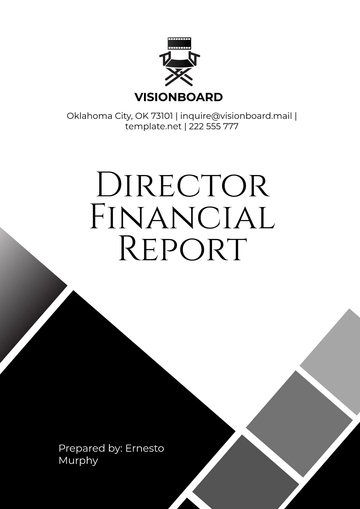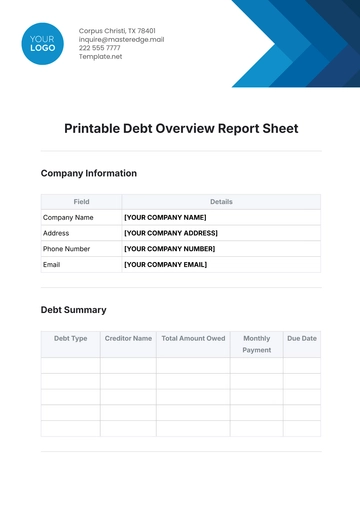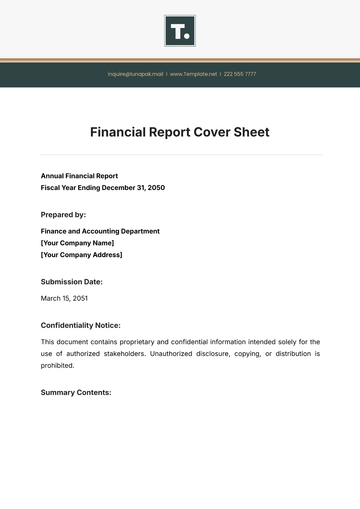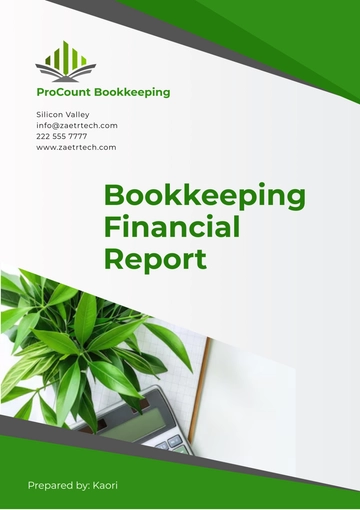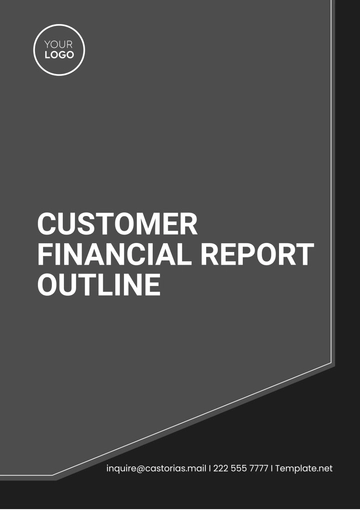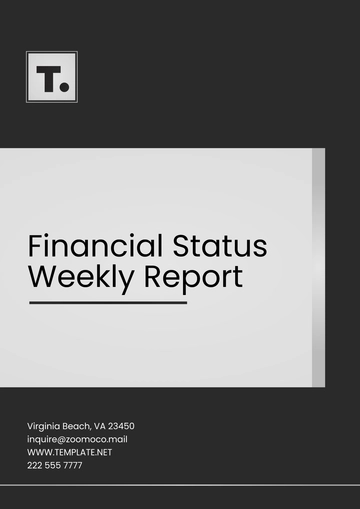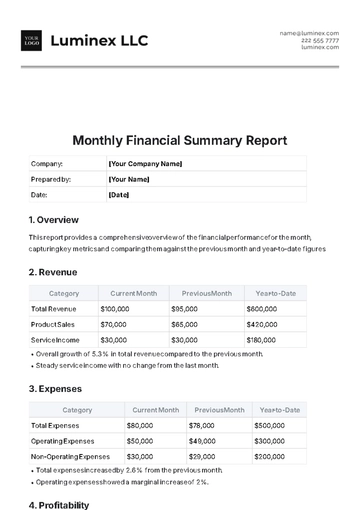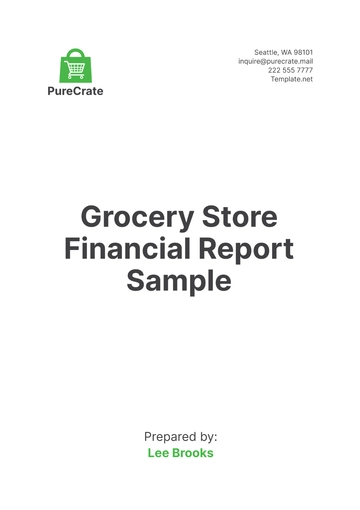Free Finance Credit Transparency Report
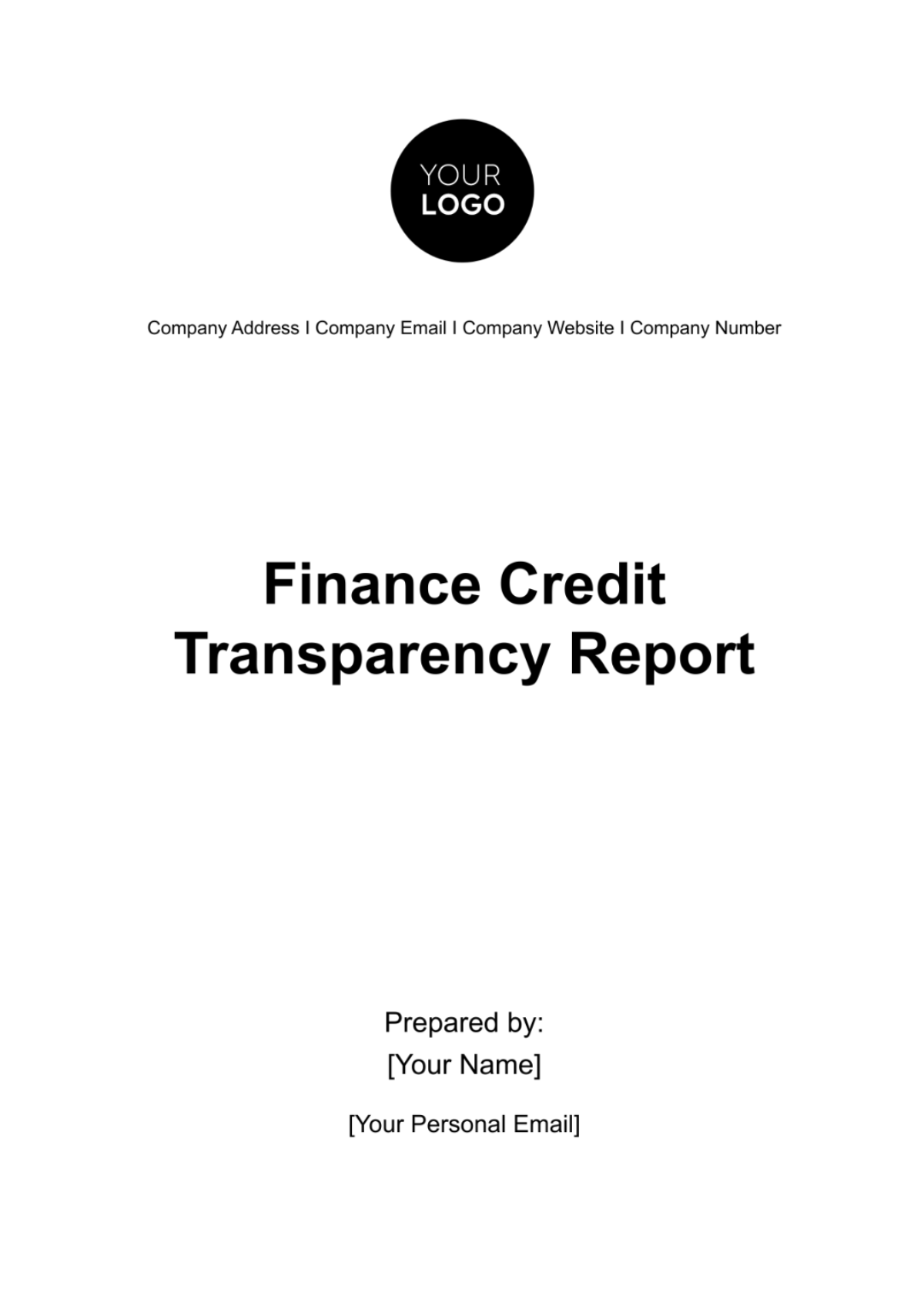
Executive Summary
The Executive Summary offers a concise yet comprehensive overview of the company's credit standing. Key metrics highlighted include the credit score, debt-to-income ratio, and overall financial health. This report primarily focuses on assessing the effectiveness and transparency of our credit management practices. It aims to identify areas for improvement to bolster our market position. Significant aspects of this report include a detailed analysis of our credit granting procedures, risk assessment methods, and adherence to regulatory standards.
Credit Policy Overview
Credit Granting Process
Our process for granting credit is designed to effectively assess the creditworthiness of applicants while minimizing risk. It involves:
Credit Scoring Models: These models incorporate historical data, payment history, credit utilization, and other financial indicators.
Risk Assessment Criteria: Our assessment criteria consider financial stability, industry sector risks, and credit history.
Application Review: Each application undergoes a thorough review by credit analysts, evaluating financial documents and credit scores.
Continuous monitoring of borrowers' financial health is conducted to adjust credit limits as necessary.
Credit Terms and Conditions
Our credit terms and conditions are clearly outlined to ensure transparency. These terms include:
Payment Terms: Standard payment terms of 30, 60, or 90 days are offered, based on the customer's creditworthiness.
Interest Rates: Interest rates are competitive and adjusted according to the customer's risk profile and market trends.
Late Payment Penalties: Penalties for late payments are enforced to promote timely repayment and are clearly stated in the credit agreement.
Table 1: Summary of Credit Terms
Credit Term | Description |
Payment Period | 30, 60, 90 days |
Interest Rates | Variable, based on risk assessment |
Late Payment Penalties | Specified in credit agreement |
This approach ensures a balanced and risk-aware credit portfolio, contributing to the company's long-term financial stability and growth.
Credit Risk Assessment
Risk Evaluation Methodology
Our risk evaluation methodology employs a comprehensive approach, integrating both quantitative and qualitative assessments. The following table outlines the key criteria used in our evaluation process:
Table 2: Risk Evaluation Criteria
Criteria | Description |
Financial Ratios | Debt-to-Income: 35%, Liquidity: 40%, Profitability: 15% |
Credit Scores | Average score: 720 (FICO scale) |
Cash Flow Analysis | Positive cash flow for 80% of borrowers |
Industry Trends | Stable growth in technology and healthcare sectors |
Market Position | Top 30% in respective industries |
Management Quality | High rating in leadership and innovation |
Portfolio Risk Analysis
Our portfolio risk analysis categorizes customers by risk levels, as detailed in the table below:
Table 3: Portfolio Risk Analysis
Customer Segment | Default Rate | Recovery Rate |
Segment A (High-Risk) | 12% | 40% |
Segment B (Medium-Risk) | 7% | 60% |
Segment C (Low-Risk) | 3% | 85% |
Risk Mitigation Strategies
We employ diversified strategies to mitigate credit risks, regularly reviewed to align with market dynamics.
Credit Performance Analysis
Credit Utilization and Trends
Our analysis of credit utilization trends provides insights into customer behavior and risk exposure:
Table 4: Credit Utilization Trends
Time Period | Average Credit Limit Usage | Repayment Rate |
Q1 2050 | 65% | 90% |
Q2 2050 | 70% | 88% |
Q3 2050 | 75% | 85% |
Q4 2050 | 68% | 92% |
Delinquency and Default Rates
The following table details the delinquency and default rates, segmented by customer type:
Table 5: Delinquency and Default Rates
Customer Type | Delinquency Rate | Default Rate |
Corporate | 9% | 4% |
Small Business | 15% | 6% |
Individual | 5% | 2% |
Recovery Performance
Our recovery performance metrics are outlined in the table below, indicating the effectiveness of our collection strategies:
Table 6: Recovery Performance Metrics
Debt Category | Average Recovery Rate | Average Recovery Duration |
High-Risk | 35% | 120 days |
Medium-Risk | 55% | 90 days |
Low-Risk | 80% | 45 days |
Regulatory Compliance and Transparency
Regulatory Requirements
In this section, we outline our adherence to the financial regulations governing credit management. We are committed to complying with all relevant laws and standards, including those set by the Financial Conduct Authority (FCA), the Consumer Financial Protection Bureau (CFPB), and other international financial regulatory bodies.
Key compliance areas include:
Lending Practices: Following fair lending laws and ensuring non-discriminatory credit practices.
Data Protection: Adhering to data privacy standards such as GDPR and CCPA, ensuring the confidentiality and security of customer information.
Financial Reporting: Complying with accounting standards and providing accurate financial disclosures.
Table 7: Compliance Overview
Regulatory Body | Compliance Area | Status |
FCA | Fair Lending Practices | Fully Compliant |
CFPB | Data Protection | Fully Compliant |
International Standards | Financial Reporting | Fully Compliant |
Transparency and Reporting Standards
Our commitment to transparency in credit management is reflected in our rigorous reporting standards. We regularly publish detailed reports on our credit portfolio, risk management practices, and financial health.
Key aspects of our reporting include:
Credit Risk Reporting: Detailed disclosures on credit risk profiles, delinquency rates, and recovery statistics.
Financial Health Metrics: Regular updates on key financial metrics such as liquidity, profitability, and leverage ratios.
Stakeholder Communication: Clear and consistent communication with stakeholders, including investors, customers, and regulatory bodies.
Future Outlook and Recommendations
Market Trends and Implications
This section analyzes current market trends and their potential impact on our credit management strategies. We observe trends such as the increasing digitization of financial services, evolving regulatory landscapes, and shifting consumer behavior patterns.
Predictions and analyses include:
Economic Forecasts: How macroeconomic conditions could affect credit demand and risk.
Technological Advancements: The impact of emerging technologies like AI and blockchain on credit management.
Regulatory Changes: Potential future changes in regulatory frameworks and their implications.
Strategic Recommendations
Based on our analysis, we propose the following strategic recommendations to enhance our credit management and performance:
Digital Transformation: Embrace digital technologies to improve risk assessment accuracy and customer service.
Diversification: Expand our credit portfolio to new sectors and customer segments to mitigate risks.
Continuous Learning: Invest in ongoing training and development for our credit management team to stay abreast of best practices and regulatory changes.
Table 8: Strategic Recommendations
Recommendation | Description | Expected Impact |
Digital Transformation | Implement AI-driven risk assessment tools | Improved risk profiling |
Portfolio Diversification | Extend credit offerings to emerging industries | Risk mitigation |
Staff Development | Regular training on new regulations and technologies | Compliance and efficiency |
Appendices
Appendix A: Detailed Data Tables
This appendix provides comprehensive data tables that offer an in-depth view of various aspects of our credit management and performance. These tables include detailed information on customer credit ratings, payment histories, and credit limit utilization, among other metrics.
Table 9: Customer Credit Ratings Distribution
Credit Rating Category | Number of Customers | Percentage of Portfolio |
Excellent (800-850) | 500 | 10% |
Very Good (740-799) | 1,500 | 30% |
Good (670-739) | 2,000 | 40% |
Fair (580-669) | 1,000 | 15% |
Poor (<580) | 500 | 5% |
Table 10: Payment History Overview
Payment Status | Number of Accounts | Percentage of Total Accounts |
On-time Payments | 4,000 | 80% |
Late (< 30 days) | 500 | 10% |
Seriously Late (>30 days) | 500 | 10% |
Table 11: Credit Limit Utilization
Credit Limit Range | Average Utilization Rate | Number of Accounts |
$0 - $5,000 | 70% | 1,000 |
$5,001 - $15,000 | 60% | 2,000 |
> $15,000 | 50% | 2,000 |
Appendix B: Glossary of Terms
This appendix serves as a glossary, defining technical terms and financial jargon used throughout this report. It aims to ensure clarity and ease of understanding for all readers, regardless of their financial expertise.
Credit Rating: A numerical expression based on a level analysis of a person's credit files, representing the creditworthiness of the individual.
Default Rate: The percentage of borrowers who fail to make required payments on their debt.
Liquidity Ratio: A measure of a company's ability to pay its short-term obligations using its most liquid assets.
Profit Margin: A financial metric used to assess a company's financial health by revealing the proportion of money left over from revenues after accounting for the cost of goods sold.
Delinquency Rate: The percentage of loans within a financial institution's loan portfolio whose payments are overdue.
- 100% Customizable, free editor
- Access 1 Million+ Templates, photo’s & graphics
- Download or share as a template
- Click and replace photos, graphics, text, backgrounds
- Resize, crop, AI write & more
- Access advanced editor
Enhance stakeholder trust with the Finance Credit Transparency Report Template from Template.net. This editable, customizable template enables clear reporting of credit operations. Essential for financial institutions, it outlines credit activities, policies, and performance, promoting transparency, building stakeholder confidence, and adhering to regulatory standards in credit reporting.
You may also like
- Sales Report
- Daily Report
- Project Report
- Business Report
- Weekly Report
- Incident Report
- Annual Report
- Report Layout
- Report Design
- Progress Report
- Marketing Report
- Company Report
- Monthly Report
- Audit Report
- Status Report
- School Report
- Reports Hr
- Management Report
- Project Status Report
- Handover Report
- Health And Safety Report
- Restaurant Report
- Construction Report
- Research Report
- Evaluation Report
- Investigation Report
- Employee Report
- Advertising Report
- Weekly Status Report
- Project Management Report
- Finance Report
- Service Report
- Technical Report
- Meeting Report
- Quarterly Report
- Inspection Report
- Medical Report
- Test Report
- Summary Report
- Inventory Report
- Valuation Report
- Operations Report
- Payroll Report
- Training Report
- Job Report
- Case Report
- Performance Report
- Board Report
- Internal Audit Report
- Student Report
- Monthly Management Report
- Small Business Report
- Accident Report
- Call Center Report
- Activity Report
- IT and Software Report
- Internship Report
- Visit Report
- Product Report
- Book Report
- Property Report
- Recruitment Report
- University Report
- Event Report
- SEO Report
- Conference Report
- Narrative Report
- Nursing Home Report
- Preschool Report
- Call Report
- Customer Report
- Employee Incident Report
- Accomplishment Report
- Social Media Report
- Work From Home Report
- Security Report
- Damage Report
- Quality Report
- Internal Report
- Nurse Report
- Real Estate Report
- Hotel Report
- Equipment Report
- Credit Report
- Field Report
- Non Profit Report
- Maintenance Report
- News Report
- Survey Report
- Executive Report
- Law Firm Report
- Advertising Agency Report
- Interior Design Report
- Travel Agency Report
- Stock Report
- Salon Report
- Bug Report
- Workplace Report
- Action Report
- Investor Report
- Cleaning Services Report
- Consulting Report
- Freelancer Report
- Site Visit Report
- Trip Report
- Classroom Observation Report
- Vehicle Report
- Final Report
- Software Report



